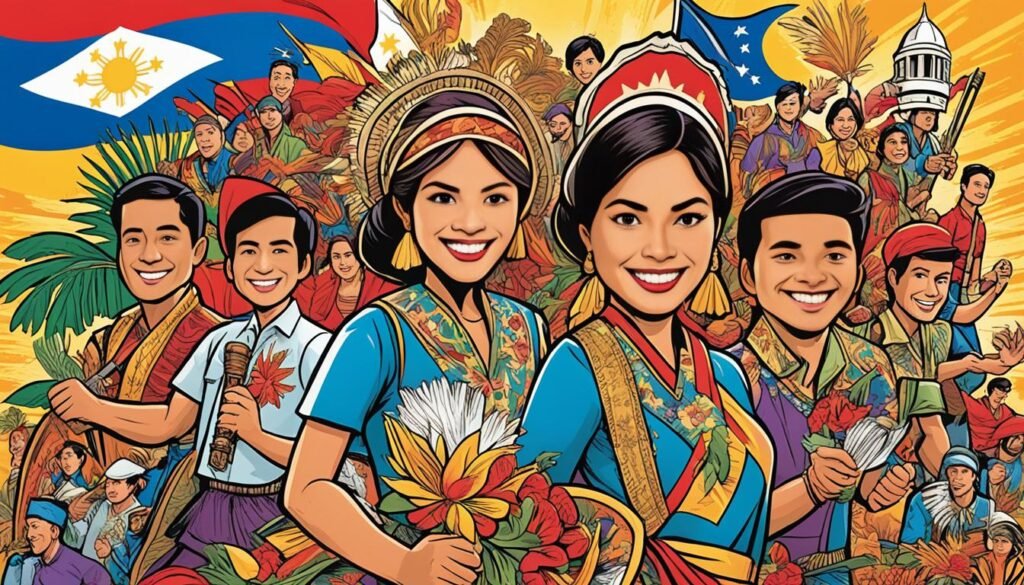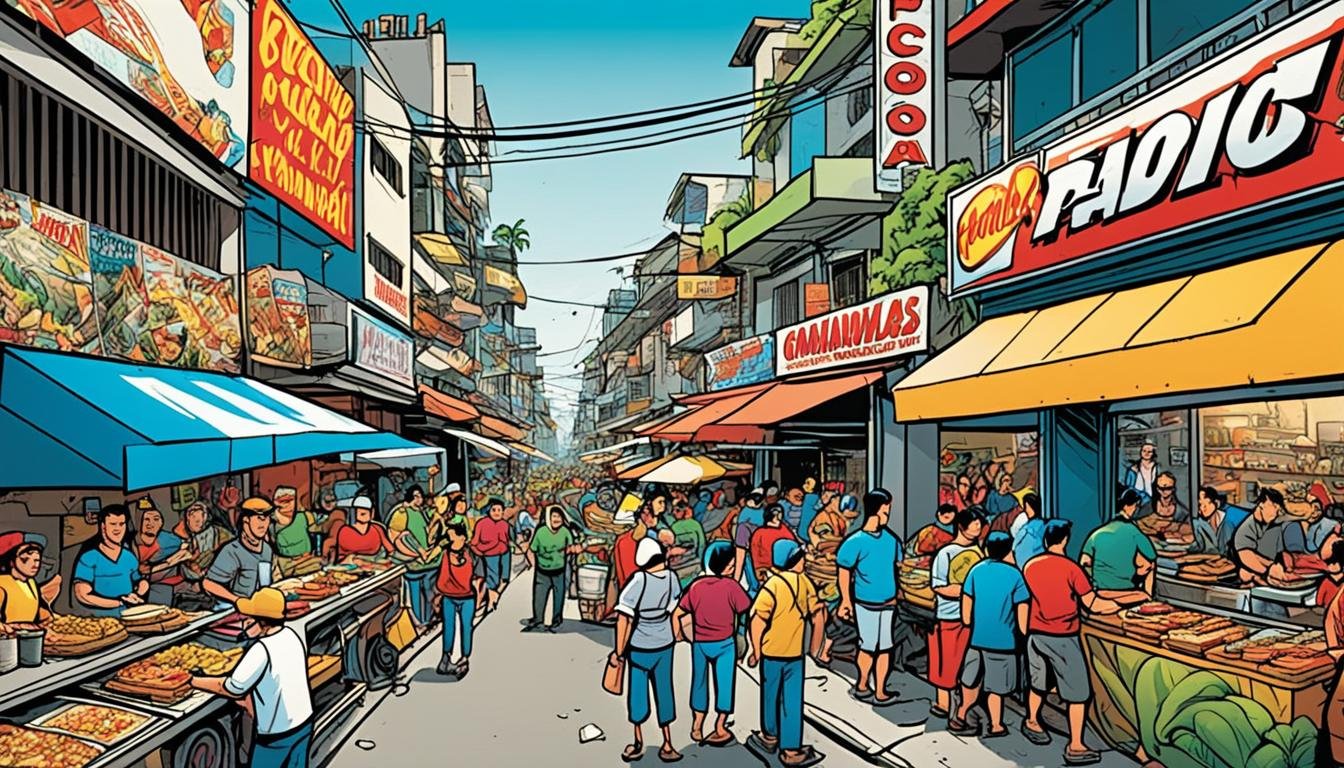Did you know that the United States had a significant impact on Philippine customs and traditions?
The Philippines, an archipelago of 7,107 islands, has a rich cultural heritage shaped by a blend of foreign influences. Among these influences, the American impact stands out as a key factor in shaping the unique Filipino culture and way of life. From language to government systems, the American presence has left an indelible mark on the country.
Key Takeaways:
- The United States has had a profound influence on Philippine customs and traditions.
- The American impact can be seen in various aspects of Filipino culture, including language, education, and entertainment.
- The Philippines’ colonial history has played a significant role in shaping its cultural identity.
- The enduring influence of American culture in the Philippines is a topic of ongoing exploration and discussion.
- Understanding the American impact is crucial for appreciating the rich and vibrant cultural heritage of the Philippines.
Geography and Climate of the Philippines
The Philippines, located in the Southeast Asia region, is a stunning archipelago consisting of 7,107 islands. This diverse country has been influenced by various cultures, including Malays, Chinese, Spaniards, Americans, and others. With a total land area of 115,600 square miles, the Philippines is divided into three primary geographical areas: Luzon, Visayas, and Mindanao.
The Philippine archipelago is known for its tropical marine climate, which is characterized by distinct seasons. The country experiences a rainy season, a dry season, and a cool season. The rainy season typically occurs between June and November, bringing occasional typhoons. The dry season, on the other hand, spans from December to May, offering warm and sunny days. Finally, the cool season emerges from December to February, providing cooler temperatures and pleasant breezes.
Aside from its fascinating climate, the Philippines boasts remarkable natural features. It is renowned for its long coastlines, which stretch approximately 22,500 miles, making it the 5th longest coastline in the world. These pristine shores are home to stunning beaches, charming coves, and magnificent coral reefs.
Furthermore, the country’s rich biodiversity is unparalleled. The Philippines is considered a biodiversity hotspot, with a vast array of plant and animal species. Its exceptional and diverse ecosystems include rainforests, mangroves, coral reefs, and marine sanctuaries, providing a haven for countless species.
The Philippines is also renowned for its active volcanoes, with a total of 22 recorded active volcanoes. Mount Mayon, located in the province of Albay, is considered one of the most beautiful and iconic volcanoes in the country, with its near-perfect cone shape.
Exploring the geography and climate of the Philippines offers a glimpse into the country’s natural wonders and breathtaking landscapes. From its captivating coastlines to its diverse ecosystems and active volcanoes, this archipelago truly showcases the beauty of Southeast Asia’s natural wonders.
Government System and Population of the Philippines
The Philippines operates under a constitutional democracy, with a President serving as the head of state. The national government is structured into three branches: executive, legislative, and judicial. This system ensures a separation of powers and provides checks and balances for effective governance.
The Philippines has a population of approximately 94 million people, making it one of the most populous countries in the world. Over 55% of the population resides on the northern island of Luzon, which includes the bustling National Capital Region. These areas experience a higher population density compared to other regions of the country.
Religion plays a significant role in the Philippines, with Roman Catholicism being the dominant faith. The country’s diverse religious landscape also includes other Christian denominations, Islam, and indigenous belief systems.

Population Distribution in the Philippines
| Region | Population | Density |
|---|---|---|
| National Capital Region | 12.9 million | 20,785 per square kilometer |
| Calabarzon | 15.3 million | 604 per square kilometer |
| Central Luzon | 11.2 million | 340 per square kilometer |
| Central Visayas | 6.8 million | 530 per square kilometer |
| Ilocos Region | 5.1 million | 317 per square kilometer |
“The Philippines’ government system ensures the smooth functioning of the democratic process, while the population distribution highlights the concentration of people in key regions. This diversity in both governance and demographics contributes to the unique fabric of the country.”
Source: eTravel Pilipinas, CIA World Fact Book
Economic Data and Challenges in the Philippines
The Philippines has a growing economy, with an estimated GDP of $351.4 billion in 2010. However, the country faces significant challenges that hinder its progress. These challenges include corruption, poor law enforcement, environmental degradation, and tax evasion.
Transparency International ranks the Philippines 134 out of 178 countries in terms of corruption perception, indicating a high level of corruption within the country. This corruption undermines public trust, stifles economic growth, and creates an uneven playing field for businesses.
Poor law enforcement is another challenge that the Philippines must address. Inadequate enforcement of laws and regulations contributes to a sense of impunity among lawbreakers, damaging investor confidence and hindering economic development.
Environmental degradation is a pressing issue in the country. Illegal logging, mining activities, and improper waste disposal practices have led to deforestation, pollution, and the destruction of natural habitats. These environmental challenges not only harm the country’s natural resources but also impact tourism, a crucial source of revenue for the Philippines.
Tax evasion is also a significant concern in the Philippines. Despite efforts to improve tax collection, many individuals and businesses still engage in illegal practices to evade paying their fair share of taxes. This undermines government revenue and limits the resources available for public services and infrastructure development.
The government of the Philippines is committed to addressing these challenges. It is actively working to eradicate corruption and improve tax collection through reforms and initiatives. Efforts are also being made to attract foreign investment and promote infrastructure development and tourism, which can drive economic growth and create job opportunities.
“The challenges of corruption, poor law enforcement, environmental degradation, and tax evasion hinder the progress of the Philippines, but the government is taking steps to address them and promote sustainable economic development.” – [Source]
Key Economic Indicators of the Philippines
| Indicator | Value |
|---|---|
| GDP | $351.4 billion (2010) |
| Corruption Perception Index | 134 out of 178 countries |
| Population | Approximately 94 million people |
This table highlights key economic indicators of the Philippines, including the country’s GDP, corruption perception index, and population. It provides a snapshot of the economic landscape, showing both the challenges and potential for growth in the country.
Despite the obstacles faced, the Philippines is striving to overcome these challenges and create a more favorable environment for economic development. Through targeted reforms, increased transparency, and focused efforts to combat corruption, the government intends to strengthen the economy, attract investment, and improve the lives of its citizens.
Conclusion
The impact of American influence on Philippine customs and traditions has significantly shaped the country’s diverse culture and language, as well as its government system and economic challenges. As a former U.S. colony, the Philippines has been influenced by a mixture of foreign cultures, with American influence playing a prominent role.
While the Philippines has made progress in addressing issues such as corruption and tax evasion, there is still ongoing work to be done. The enduring impact of American influence on Philippine culture remains a topic of discussion and exploration.
Understanding the impact of American influence on the Philippines is crucial for appreciating the rich and vibrant cultural heritage of the country. It allows us to recognize the historical, social, and linguistic connections that have been formed over the years. The fusion of Philippine and American influences has given rise to a unique and ever-evolving identity that sets the country apart.
As the Philippines continues to grow and develop, it is important to acknowledge and preserve its cultural heritage. By embracing the influences of the past, the country can pave the way for a more prosperous and harmonious future.
FAQ
What is the influence of the United States on Philippine customs and traditions?
The United States has had a significant impact on Philippine customs and traditions. This influence is visible in aspects such as language, culture, government systems, and economic challenges. The American period of colonization has left a lasting imprint on the Philippines.
How many islands does the Philippines have?
The Philippines is an archipelago comprised of 7,107 islands. This makes it a unique and geographically diverse country in Southeast Asia.
What is the climate like in the Philippines?
The Philippines has a tropical marine climate characterized by a rainy season, a dry season, and a cool season. This climate contributes to the country’s lush green landscapes and biodiversity.
What is the government system of the Philippines?
The Philippines is a constitutional democracy with a President as the head of state. The government is divided into three branches: executive, legislative, and judicial.
What is the population of the Philippines?
The Philippines has a population of approximately 94 million people. The majority of the population, over 55%, resides on the northern island of Luzon.
What are the economic challenges faced by the Philippines?
The Philippines has a growing economy but faces challenges such as corruption, poor law enforcement, environmental degradation, and tax evasion. Efforts are being made to address these issues and attract foreign investment, promote infrastructure development, and boost tourism.
Source Links
- https://www-pub.iaea.org/mtcd/publications/pdf/cnpp2012_cd/countryprofiles/Philippines/Philippines.htm
- https://magazine.ethisphere.com/global-compliance-philippines/
- https://docs.lib.purdue.edu/cgi/viewcontent.cgi?article=1165&context=jsaaea

